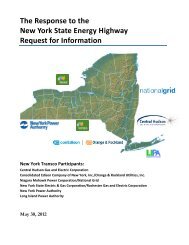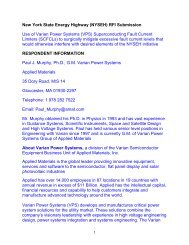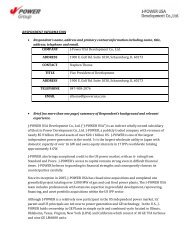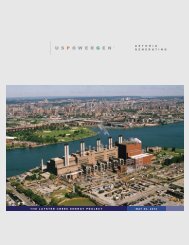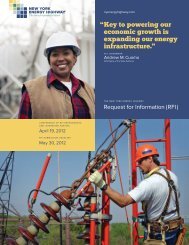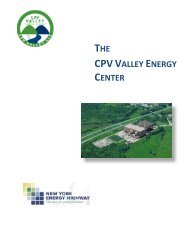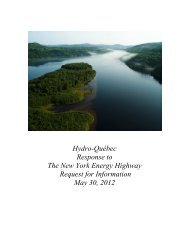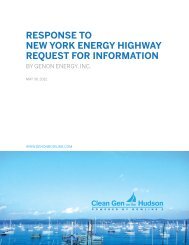Beacon Power, LLC Response to the New York Energy Highway ...
Beacon Power, LLC Response to the New York Energy Highway ...
Beacon Power, LLC Response to the New York Energy Highway ...
Create successful ePaper yourself
Turn your PDF publications into a flip-book with our unique Google optimized e-Paper software.
<strong>Beacon</strong> <strong>Power</strong>, <strong>LLC</strong><br />
<strong>Response</strong> <strong>to</strong> <strong>the</strong> <strong>New</strong> <strong>York</strong> <strong>Energy</strong> <strong>Highway</strong> Request for Information (RFI)<br />
May 30, 2012<br />
RESPONDENT INFORMATION<br />
<strong>Beacon</strong> <strong>Power</strong>, <strong>LLC</strong> (“<strong>Beacon</strong> <strong>Power</strong>” or <strong>the</strong> “Company”), a manufacturer and merchant<br />
developer of an innovative flywheel energy s<strong>to</strong>rage technology, is pleased <strong>to</strong> provide this<br />
response <strong>to</strong> <strong>the</strong> <strong>New</strong> <strong>York</strong> <strong>Energy</strong> <strong>Highway</strong> Request for Information (“RFI”). <strong>Beacon</strong> <strong>Power</strong> has<br />
developed and now operates a 20-megawatt (“MW”) flywheel energy s<strong>to</strong>rage plant located in<br />
Stephen<strong>to</strong>wn, <strong>New</strong> <strong>York</strong>, which currently provides Frequency Regulation service in NYISO’s<br />
Regulation market. <strong>Beacon</strong> <strong>Power</strong>’s flywheel energy s<strong>to</strong>rage technology is a clean, reliable,<br />
low-cost solution for improving reliability and reducing congestion on <strong>the</strong> power grid.<br />
Communications and correspondence related <strong>to</strong> this submission should be directed <strong>to</strong>:<br />
Judith Judson McQueeney<br />
Vice President, Asset Management and Market Development<br />
<strong>Beacon</strong> <strong>Power</strong>, <strong>LLC</strong><br />
65 Middlesex Road<br />
Tyngsboro, MA 01879<br />
Tel: (978) 661-2070<br />
Fax: (978) 694-9127<br />
mcqueeney@beaconpower.com<br />
ORGANIZATION OF RESPONSE<br />
This response is organized in<strong>to</strong> three sections. The first section discusses <strong>the</strong> use and<br />
benefits of flywheel energy s<strong>to</strong>rage for providing reliability services <strong>to</strong> <strong>the</strong> power grid, such as<br />
frequency regulation, through NYISO’s Ancillary Services markets. The second section discusses<br />
<strong>the</strong> use and benefits of flywheel energy s<strong>to</strong>rage for reducing congestion on <strong>the</strong> transmission<br />
1
system. The last section discusses policy recommendations <strong>to</strong> increase <strong>the</strong> use of energy<br />
s<strong>to</strong>rage technologies on <strong>the</strong> grid in order <strong>to</strong> provide reliable, affordable power <strong>to</strong> <strong>New</strong> <strong>York</strong>’s<br />
homes and businesses.<br />
I. S<strong>to</strong>rage Resources as Frequency Regulation Service Providers<br />
A. Project Description<br />
Since January 2011, <strong>Beacon</strong> <strong>Power</strong> has been operating its first 20 MW commercial-scale<br />
flywheel energy s<strong>to</strong>rage plant located in Stephen<strong>to</strong>wn, <strong>New</strong> <strong>York</strong> (Rennselaer County, NYISO<br />
Zone F) . The plant provides frequency regulation service <strong>to</strong> <strong>the</strong> grid through <strong>the</strong> NYISO’s<br />
Ancillary Service Regulation market. <strong>Beacon</strong> <strong>Power</strong> is interested in building additional flywheel<br />
energy s<strong>to</strong>rage plants in <strong>New</strong> <strong>York</strong> State.<br />
B. Project Justification<br />
In order <strong>to</strong> reliably deliver power <strong>to</strong> consumers, <strong>the</strong> grid must stay at a constant<br />
frequency of 60 Hertz per second. This requires that <strong>the</strong> supply of electricity by genera<strong>to</strong>rs and<br />
<strong>the</strong> demand for electricity by consumers stay in perfect balance. However, supply and demand<br />
is constantly fluctuating and varies second by second. The NYISO maintains reliability and<br />
manages <strong>the</strong>se fluctuations by buying Regulation Service through its wholesale power market.<br />
Today regulation service is typically provided by genera<strong>to</strong>rs who increase or decrease <strong>the</strong>ir<br />
output. But this approach has limitations. Because genera<strong>to</strong>rs operate most efficiently at a<br />
constant output, rapid changes in power delivery cause <strong>the</strong>m <strong>to</strong> consume more fuel, require<br />
more maintenance and produce higher emissions. A better solution is <strong>to</strong> s<strong>to</strong>re energy for brief<br />
periods of time. This is what <strong>Beacon</strong> <strong>Power</strong>’s flywheel technology can do. Our technology<br />
operates by using flywheels <strong>to</strong> rapidly recycle excess energy on <strong>the</strong> grid. When generated<br />
power exceeds load, <strong>Beacon</strong> <strong>Power</strong>’s flywheels s<strong>to</strong>re this excess energy. When load increases,<br />
<strong>Beacon</strong>’s flywheels return <strong>the</strong> energy <strong>to</strong> <strong>the</strong> grid. <strong>Beacon</strong> <strong>Power</strong>’s technology can respond<br />
nearly instantaneously <strong>to</strong> NYISO’s control signal. The ability of <strong>Beacon</strong> <strong>Power</strong>’s flywheels <strong>to</strong><br />
quickly and precisely respond <strong>to</strong> moment-by-moment system changes make this technology<br />
ideally suited <strong>to</strong> provide frequency regulation.<br />
2
There a several benefits of using flywheel s<strong>to</strong>rage for frequency regulation that align<br />
with <strong>the</strong> <strong>Energy</strong> <strong>Highway</strong> Objectives:<br />
1.<br />
As a new, fast, accurate resource for maintaining grid frequency, flywheel energy<br />
s<strong>to</strong>rage assures that long-term reliability of <strong>the</strong> electric system is cost-effectively<br />
maintained, benefiting system performance and operations.<br />
<strong>Beacon</strong> <strong>Power</strong>’s technology provides a fast response solution for maintaining grid<br />
reliability. With a 25 kWh/100 kW flywheel system, <strong>Beacon</strong>’s technology can respond <strong>to</strong> an<br />
ISO’s control signal up <strong>to</strong> one hundred times faster than what is offered by traditional<br />
genera<strong>to</strong>rs. Since fast regulation resources are significantly more effective at responding <strong>to</strong><br />
system imbalances than slower-ramping generation resources, <strong>the</strong>ir use on <strong>the</strong> grid can lower<br />
<strong>the</strong> overall amount of Regulation that needs <strong>to</strong> be purchased <strong>to</strong> maintain system reliability.<br />
The following example shows <strong>the</strong> greater effectiveness provided by using flywheel<br />
energy s<strong>to</strong>rage for frequency regulation. On September 25, 2011, at hour ending 16, <strong>Beacon</strong>’s<br />
flywheel regulation plant in Stephen<strong>to</strong>wn, NY supplied 20 MW of Regulation capacity <strong>to</strong> <strong>the</strong><br />
NYISO regulation market, or 11% of <strong>the</strong> <strong>to</strong>tal 175 MW of Regulation capacity procured during<br />
<strong>the</strong> hour. 1 Based upon data provided by NYISO, during that hour <strong>the</strong> <strong>to</strong>tal Area Control Error<br />
(“ACE”), which is a measurement of <strong>the</strong> frequency error and system imbalance on <strong>the</strong> grid, was<br />
44.3 MWh (<strong>the</strong> sum of positive ACE MWh with <strong>the</strong> absolute value of negative ACE MWh). 2 In<br />
this hour, <strong>Beacon</strong>’s 20 MW flywheel plant provided 14.2 MWh of energy <strong>to</strong> correct ACE or<br />
32.2% of <strong>the</strong> <strong>to</strong>tal ACE Correction due its ability <strong>to</strong> respond in seconds <strong>to</strong> <strong>the</strong> error. For <strong>the</strong><br />
same hour, <strong>Beacon</strong> <strong>Power</strong> modeled a traditional genera<strong>to</strong>r supplying 20 MW of Regulation<br />
capacity with <strong>the</strong> allowable 5-minute response time following NYISO’s pro-rated control signal<br />
derived from ACE. Based on its models, <strong>the</strong> genera<strong>to</strong>r would be dispatched <strong>to</strong> provide 3.7<br />
MWh of energy <strong>to</strong> correct ACE correction, or just 8.3% of <strong>the</strong> <strong>to</strong>tal ACE Correction needed. (See<br />
Figure 1). The blue line is <strong>the</strong> actual amount of regulation service provided by <strong>Beacon</strong> <strong>Power</strong>’s<br />
20 MW flywheel plant by responding every 6-seconds <strong>to</strong> <strong>the</strong> NYISO dispatch signal and <strong>the</strong> red<br />
line shows <strong>the</strong> amount of regulation service provided by a 20 MW resource with a 5-minute<br />
response time.<br />
1 NYISO Regulation Requirements, http://www.nyiso.com/public/webdocs/market_data/reports_info/nyiso_regulation_req.pdf,<br />
Accessed 9/26/11.<br />
2 Area Control Error (“ACE”) is defined by NERC as “The instantaneous difference between a Balancing Authority’s net actual<br />
and scheduled interchange, taking in<strong>to</strong> account <strong>the</strong> effects of Frequency Bias and correction for meter error.” ACE data<br />
provided by NYISO. System ACE data is telemetered <strong>to</strong> Stephen<strong>to</strong>wn plant in conjunction with <strong>the</strong> plant’s specific dispatch<br />
signal.<br />
3
Figure 1. Comparison of <strong>the</strong> amount of Frequency Regulation Service (ACE Correction)<br />
provided by <strong>Beacon</strong>’s flywheel plant versus a Traditional Genera<strong>to</strong>r<br />
In this hour <strong>the</strong> fast-ramping flywheel provided almost four times <strong>the</strong> ACE Correction (or<br />
frequency regulation) as <strong>the</strong> slow-ramping resource with <strong>the</strong> same amount of capacity (20<br />
MW). By providing a significantly greater amount of frequency regulation service per MW of<br />
capacity, flywheels provide a cost-effective solution for <strong>to</strong> maintaining system reliability thus<br />
maximizing ratepayer value.<br />
2.<br />
Contributes <strong>to</strong> an environmentally sustainable future for <strong>New</strong> <strong>York</strong> State and<br />
supports <strong>the</strong> development of utility-scale renewable generation resources<br />
throughout <strong>the</strong> state.<br />
In Oc<strong>to</strong>ber 2008, NYISO issued a paper entitled, “Integration of Wind in<strong>to</strong> System<br />
Dispatch” wherein it notes that “wind plants may create a significant demand for increased<br />
regulation and reserves, thus making it imperative <strong>to</strong> look for new sources and new<br />
3<br />
technologies for <strong>the</strong>se services.” More recently, NYISO has reported that an increase of 54%<br />
in <strong>the</strong> Regulation requirement can be expected with <strong>the</strong> forecasted increase in intermittent<br />
renewable resources. 4 Flywheel <strong>Energy</strong> S<strong>to</strong>rage enables very fast and accurate response <strong>to</strong><br />
3 Integration of Wind in<strong>to</strong> System Dispatch, A <strong>New</strong> <strong>York</strong> ISO White Paper, Oc<strong>to</strong>ber 2008.<br />
4 NYISO “Growing Wind Final Report of <strong>the</strong> NYISO 2010 Wind Generation Study” September 2010.<br />
4
frequent and unpredictable wind and solar ramping events and hence can reduce <strong>the</strong> overall<br />
expense of regulation reserves required <strong>to</strong> integrate wind.<br />
Flywheel energy s<strong>to</strong>rage technologies can provide Regulation Service a la carte. This<br />
reduces <strong>the</strong> need <strong>to</strong> run additional generation units at night in order compensate for overgeneration<br />
by wind resources. When <strong>the</strong> wind blows during off-peak hours, few genera<strong>to</strong>rs will<br />
be on-line <strong>to</strong> provide Regulation Service. Those genera<strong>to</strong>rs that are operating are likely <strong>to</strong> be<br />
running at or near <strong>the</strong>ir minimum operating level, meaning that <strong>the</strong>y would be unavailable <strong>to</strong><br />
provide Regulation Down service. This over–generation situation is fur<strong>the</strong>r exacerbated by<br />
needing <strong>to</strong> ei<strong>the</strong>r move <strong>the</strong>se units above <strong>the</strong>ir minimum operating level or bringing additional<br />
units on-line for Regulation service if those operating are not Regulation-capable. Conversely,<br />
advanced energy s<strong>to</strong>rage can provide Regulation a la carte. With <strong>Beacon</strong> <strong>Power</strong>’s flywheel<br />
energy s<strong>to</strong>rage on <strong>the</strong> system, opera<strong>to</strong>rs will not need <strong>to</strong> ramp up genera<strong>to</strong>rs operating in offpeak<br />
hours, or bring on additional generation <strong>to</strong> provide Regulation Service.<br />
Flywheel energy s<strong>to</strong>rage produces fewer emissions when providing Regulation than<br />
conventional generation. Unlike genera<strong>to</strong>rs that consume fossil fuel, <strong>Beacon</strong> <strong>Power</strong>’s flywheel<br />
technology recycles existing power, <strong>the</strong>reby lowering its operating costs <strong>to</strong> provide regulation<br />
and benefiting <strong>the</strong> environment by producing zero direct CO2 greenhouse gas, particulates or<br />
o<strong>the</strong>r air emissions. 5 A study by KEMA concluded that a 20 MW Flywheel <strong>Energy</strong> S<strong>to</strong>rage<br />
System emits 56% less CO2 than a natural gas power plant providing regulation and 26% less<br />
emissions than a pumped hydro power plant. 6 KEMA notes that continued reliance on <strong>the</strong>rmal<br />
generating units <strong>to</strong> meet increased regulation requirements could actually increase emissions<br />
of CO2, NOX and o<strong>the</strong>r pollutants, <strong>the</strong>reby defeating one of <strong>the</strong> main benefits of wind<br />
generation. 7<br />
3.<br />
Maximizes <strong>New</strong> <strong>York</strong> state ratepayer value in <strong>the</strong> operation of power grid.<br />
As discussed above, by providing a significantly greater amount of frequency regulation<br />
service per MW of capacity, flywheel energy s<strong>to</strong>rage can provide a cost-effective solution for<br />
maintaining system reliability thus maximizing ratepayer value. In addition, flywheel energy<br />
s<strong>to</strong>rage has <strong>the</strong> potential <strong>to</strong> reduce Regulation costs for ratepayers by introducing new<br />
competition <strong>to</strong> NYISO’s regulation market and displacing high cost conventional generation.<br />
<strong>Beacon</strong> <strong>Power</strong>’s flywheel technology is a lower cost alternative than conventional<br />
generation for regulation. <strong>Beacon</strong> <strong>Power</strong> has a fundamental operating cost advantage because<br />
5 Some emissions from flywheels occur indirectly, because some electricity from <strong>the</strong> grid must be used <strong>to</strong><br />
compensate for energy losses during operation.<br />
6 KEMA, Emissions Comparison for a 20MW Flywheel-based Frequency Regulation <strong>Power</strong> Plant, May 18, 2007.<br />
7 Id.<br />
5
it does not consume fossil fuel. Instead flywheels recycle existing power. That coupled with its<br />
high operating efficiency and low maintenance makes <strong>Beacon</strong> <strong>Power</strong> a low cost regulation<br />
provider. The introduction of new competition <strong>to</strong> <strong>the</strong> market will displace high-cost regulation<br />
deployments by traditional genera<strong>to</strong>rs.<br />
4.<br />
Using flywheels on <strong>the</strong> grid can increase <strong>the</strong> efficiency of traditional power<br />
generation plants.<br />
Existing fossil fuel-powered plants displaced by <strong>Beacon</strong> <strong>Power</strong>’s flywheel-based<br />
frequency regulation can be shifted <strong>to</strong> provide a corresponding amount of added generation<br />
capacity. In doing so, <strong>the</strong>se plants can run at <strong>the</strong>ir optimum capacity, improving <strong>the</strong>ir heat rate<br />
efficiency, reducing wear and tear on <strong>the</strong>ir equipment, <strong>the</strong>reby potentially lowering <strong>the</strong>ir cost<br />
<strong>to</strong> produce energy. The regained capacity from traditional genera<strong>to</strong>rs does not require<br />
permitting or construction time, enabling regions <strong>to</strong> increase peak power generation without<br />
<strong>the</strong> need for new power plants.<br />
5. Create jobs and opportunities for <strong>New</strong> <strong>York</strong>ers.<br />
The construction and operation of our Stephen<strong>to</strong>wn project has provided job<br />
opportunities in <strong>New</strong> <strong>York</strong>. <strong>Beacon</strong> <strong>Power</strong> used LeChase Construction Services, <strong>LLC</strong>, a <strong>New</strong><br />
<strong>York</strong>-based firm, <strong>to</strong> construct <strong>the</strong> Stephen<strong>to</strong>wn project. In addition, <strong>the</strong> plant utilizes local<br />
contrac<strong>to</strong>rs <strong>to</strong> perform on-going plant maintenance.<br />
C. Financial Information<br />
The project received a DOE Loan Guarantee and a $2 million NYSERDA grant.<br />
D. Permit/Approval Process<br />
The Stephen<strong>to</strong>wn project is currently operational, it has received all required permits<br />
and approvals and requires no fur<strong>the</strong>r permits.<br />
II. S<strong>to</strong>rage Resources as Transmission System Resources<br />
A. Project Description<br />
Flywheel energy s<strong>to</strong>rage can be used <strong>to</strong> reduce local transmission congestion. This can<br />
be accomplished by locating <strong>the</strong> s<strong>to</strong>rage resource in <strong>the</strong> downstate area such that it provides<br />
6
power at times when local demand would o<strong>the</strong>rwise cause transmission congestion. Alleviating<br />
congestion is achieved by s<strong>to</strong>ring energy during times of low demand, and releasing it when<br />
increased local demand would o<strong>the</strong>rwise cause an overload on <strong>the</strong> transmission line. In<br />
addition, co-locating <strong>the</strong> energy s<strong>to</strong>rage resource with an intermittent renewable resource such<br />
as wind can provide firming such that <strong>the</strong> renewable resource has reduced variability.<br />
B. Project Justification<br />
Using s<strong>to</strong>rage technologies <strong>to</strong> relieve transmission congestion meets <strong>the</strong> State’s goal of<br />
applying advanced technologies such as energy s<strong>to</strong>rage that benefit system performance and<br />
operations. This is accomplished by locally reducing transmission congestion with energy<br />
s<strong>to</strong>rage alone or in combination with providing firming of intermittent resources such as wind.<br />
Both stand alone energy s<strong>to</strong>rage projects, and <strong>the</strong> combination with a renewable energy<br />
resource solve <strong>the</strong> problem of transmission congestion with zero direct emissions. The use of<br />
s<strong>to</strong>rage <strong>to</strong> improve <strong>the</strong> existing transmission capability will 1) reduce constraints on <strong>the</strong> flow of<br />
electricity, 2) expand <strong>the</strong> diversity of power generation sources, 3) assure long-term reliability,<br />
4) contribute <strong>to</strong> an environmentally sustainable future for <strong>New</strong> <strong>York</strong> state.<br />
C. Financial Information<br />
The use of s<strong>to</strong>rage on <strong>the</strong> transmission and/or distribution system should be part of <strong>the</strong><br />
utility’s infrastructure and eligible for rate-based cost recovery. Companies, such as <strong>Beacon</strong><br />
<strong>Power</strong>, can sell turnkey s<strong>to</strong>rage solutions <strong>to</strong> <strong>the</strong> utility.<br />
D. Permit/Approval Process<br />
<strong>Beacon</strong> <strong>Power</strong>’s flywheels do not consume fuel nor produce particulates or o<strong>the</strong>r<br />
harmful emissions. This helps make it possible <strong>to</strong> rapidly permit and site a flywheel-based plant<br />
almost anywhere on <strong>the</strong> grid relatively close <strong>to</strong> a transmission or distribution line.<br />
III. Policy Recommendations<br />
<strong>Beacon</strong> <strong>Power</strong> suggests several policy recommendations increase <strong>the</strong> use of advanced energy<br />
s<strong>to</strong>rage technologies, such as flywheels, on <strong>the</strong> <strong>New</strong> <strong>York</strong> power grid.<br />
‣ Include energy s<strong>to</strong>rage technologies in <strong>the</strong> State’s Renewable Portfolio Standard.<br />
As discussed above, s<strong>to</strong>rage has zero direct emissions and is an enabler of additional<br />
renewable energy generation from sources such as wind and solar. Therefore, we recommend<br />
that <strong>the</strong> <strong>New</strong> <strong>York</strong> RPS be revised <strong>to</strong> include flywheel energy s<strong>to</strong>rage, and o<strong>the</strong>r advanced<br />
s<strong>to</strong>rage technologies, as an eligible electric generation source. In Massachusetts, flywheel<br />
7
energy s<strong>to</strong>rage has been eligible for Alternative <strong>Energy</strong> Certificates (AEC) that are used <strong>to</strong> meet<br />
<strong>the</strong> state’s Alternative <strong>Energy</strong> Portfolio Standard (“APS”) since 2009. 8 In <strong>New</strong> <strong>York</strong>, existing RPS<br />
methodologies can be borrowed <strong>to</strong> recognize emission reductions from energy s<strong>to</strong>rage.<br />
Fur<strong>the</strong>rmore, since July 2010 flywheel energy s<strong>to</strong>rage has been included in <strong>the</strong><br />
definition of Alternate <strong>Energy</strong> Production Facility in NY Public Service Law. 9 Alternate energy<br />
production facilities are excluded from <strong>the</strong> definition of "electric corporation" under NY PSL and<br />
<strong>the</strong>refore are exempt from <strong>New</strong> <strong>York</strong> Public Service Commission (PSC) jurisdiction and do not<br />
require a certificate of public convenience and necessity (CPCN) <strong>to</strong> begin construction. The<br />
definition of Alternate <strong>Energy</strong> Production facility includes <strong>the</strong> following types of resources,<br />
“solar, wind turbine, fuel cell, tidal, wave energy, waste management resource recovery,<br />
refuse-derived fuel, wood burning facility, or energy s<strong>to</strong>rage device utilizing batteries, flow<br />
batteries, flywheels or compressed air” (PSL Section 2-b). The technologies included in <strong>the</strong><br />
alternate energy production facility definition, with <strong>the</strong> exception of energy s<strong>to</strong>rage resources,<br />
are eligible resources under <strong>the</strong> NY RPS. Therefore, we urge policy makers <strong>to</strong> consider adding<br />
advanced energy s<strong>to</strong>rage systems <strong>to</strong> <strong>the</strong> list of eligible resources under <strong>the</strong> NY RPS.<br />
‣ Include energy s<strong>to</strong>rage in transmission planning and procurement<br />
As discussed above, flywheels, and o<strong>the</strong>r advanced s<strong>to</strong>rage technologies, can be used <strong>to</strong> reduce<br />
transmission congestion. Utility and regional planning should evaluate energy s<strong>to</strong>rage as a transmission<br />
and distribution alternative. We recommend that policies allow utilities and transmission owners <strong>to</strong><br />
recover investments in s<strong>to</strong>rage assets in <strong>the</strong>ir rate-base.<br />
‣ Allow s<strong>to</strong>rage <strong>to</strong> qualify as a Capacity resource<br />
Capacity procurement and markets should allow energy s<strong>to</strong>rage <strong>to</strong> participate in <strong>the</strong> process.<br />
S<strong>to</strong>rage used for frequency regulation, and o<strong>the</strong>r ancillary services, enables existing fossil fuelpowered<br />
plants <strong>to</strong> dedicate greater capacity <strong>to</strong> energy production and produce power more<br />
efficiently. Traditional plants displaced by <strong>Beacon</strong> <strong>Power</strong>’s flywheel-based frequency regulation<br />
can be shifted <strong>to</strong> provide a corresponding amount of added generation capacity. In addition,<br />
s<strong>to</strong>rage can be an effective resource for providing energy capacity at peak periods and firming<br />
<strong>the</strong> capacity from wind or o<strong>the</strong>r renewable resources.<br />
8 Massachusetts Alternative <strong>Energy</strong> Portfolio Standard (APS), 225 CMR 16.00.<br />
9 The addition of flywheels <strong>to</strong> this law was based on <strong>New</strong> <strong>York</strong>'s Public Service Commission (PSC) departmental<br />
bills S.7145 Aubertine and A.10216 Cahill, which added kinetic energy s<strong>to</strong>rage devices -- specifically flywheels<br />
and compressed air s<strong>to</strong>rage -- <strong>to</strong> <strong>the</strong> alternate energy production facility definition. Governor David A. Paterson<br />
signed <strong>the</strong> legislation in<strong>to</strong> law on July 21, 2010. On March 25, 2011 battery s<strong>to</strong>rage was added <strong>to</strong> <strong>the</strong> definition.<br />
8



